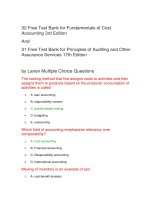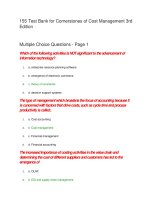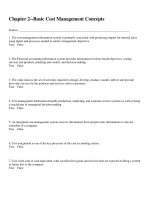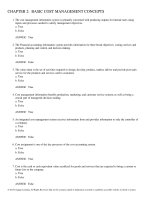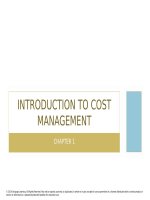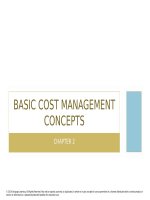Cornerstones of cost management 3rd edition hansen mowen chapter 2
Bạn đang xem bản rút gọn của tài liệu. Xem và tải ngay bản đầy đủ của tài liệu tại đây (1.01 MB, 35 trang )
BASIC COST MANAGEMENT
CONCEPTS
CHAPTER 2
© 2014 Cengage Learning. All Rights Reserved. May not be copied, scanned, or duplicated, in whole or in part, except for use as permitted in a license distributed with a certain product or
service or otherwise on a password-protected website for classroom use.
CHAPTER 2 OBJECTIVE
1. Describe a cost management information
system, its objectives, and its major
subsystems, and indicate how it relates
to other operating and information
systems
2. Explain the cost assignment process
3. Define tangible and intangible products,
and explain why there are different
product cost definitions
© 2014 Cengage Learning. All Rights Reserved. May not be copied, scanned, or duplicated, in whole or in part, except for use as permitted in a license distributed with a certain product or
service or otherwise on a password-protected website for classroom use.
CHAPTER 2 OBJECTIVE
4. Prepare income statements for
manufacturing and service organizations
5. Explain the difference between traditional
and contemporary cost management
systems
© 2014 Cengage Learning. All Rights Reserved. May not be copied, scanned, or duplicated, in whole or in part, except for use as permitted in a license distributed with a certain product or
service or otherwise on a password-protected website for classroom use.
A SYSTEMS FRAMEWORK
• System: a set of interrelated parts that
performs one or more processes to
accomplish specific objectives
• Works by using processes to transform inputs
into outputs
LO-1
© 2014 Cengage Learning. All Rights Reserved. May not be copied, scanned, or duplicated, in whole or in part, except for use as permitted in a license distributed with a certain product or
service or otherwise on a password-protected website for classroom use.
A SYSTEMS FRAMEWORK
Accounting Information Systems
•Provides information to people in a company
•Collects, classifies, summarizes, analyzes, and
manages data to provide information to users
•Inputs are usually economic events
•The operational model is critically involved with the
user of information
•Two major subsystems
• The financial accounting information system
• The cost management information system
LO-1
© 2014 Cengage Learning. All Rights Reserved. May not be copied, scanned, or duplicated, in whole or in part, except for use as permitted in a license distributed with a certain product or
service or otherwise on a password-protected website for classroom use.
EXHIBIT 2.2—OPERATIONAL MODEL OF AN
ACCOUNTING INFORMATION SYSTEM
LO-1
© 2014 Cengage Learning. All Rights Reserved. May not be copied, scanned, or duplicated, in whole or in part, except for use as permitted in a license distributed with a certain product or
service or otherwise on a password-protected website for classroom use.
A SYSTEMS FRAMEWORK
Financial Accounting Information
System
•Primarily concerned with producing outputs for
external users
•Inputs: well-specified economic events
•Processes: rules and conventions established by
the SEC, FASB, and IASB
•Outputs: financial statements for external users
LO-1
© 2014 Cengage Learning. All Rights Reserved. May not be copied, scanned, or duplicated, in whole or in part, except for use as permitted in a license distributed with a certain product or
service or otherwise on a password-protected website for classroom use.
A SYSTEMS FRAMEWORK
Cost Management Information System
•Primarily concerned with producing outputs for
internal users using inputs and processes needed
to satisfy management objectives
•Inputs and processes: set by management; not
bound by externally imposed criteria
•Provides information for three broad objectives
• Cost services, products, and other objects
• Planning and control
• Decision making
LO-1
© 2014 Cengage Learning. All Rights Reserved. May not be copied, scanned, or duplicated, in whole or in part, except for use as permitted in a license distributed with a certain product or
service or otherwise on a password-protected website for classroom use.
A SYSTEMS FRAMEWORK
• Value chain: set of activities required to
design, develop, produce, market, deliver,
and provide post-sales service
LO-1
© 2014 Cengage Learning. All Rights Reserved. May not be copied, scanned, or duplicated, in whole or in part, except for use as permitted in a license distributed with a certain product or
service or otherwise on a password-protected website for classroom use.
EXHIBIT 2.3—THE VALE CHAIN
LO-1
© 2014 Cengage Learning. All Rights Reserved. May not be copied, scanned, or duplicated, in whole or in part, except for use as permitted in a license distributed with a certain product or
service or otherwise on a password-protected website for classroom use.
A SYSTEMS FRAMEWORK
Relationship to Other Operational
Systems and Functions
•An integrated cost management system
receives information from and provides
information to all operational systems
•Enterprise resource planning systems:
integrative, cross-functional systems that
coordinate information to facilitate timely and
accurate reporting and decision making
LO-1
© 2014 Cengage Learning. All Rights Reserved. May not be copied, scanned, or duplicated, in whole or in part, except for use as permitted in a license distributed with a certain product or
service or otherwise on a password-protected website for classroom use.
A SYSTEMS FRAMEWORK
Different Systems for Different Purposes
•Cost accounting information system:
assigns costs to individual products and services
and other objects of interest to managers
•Operational control information system:
provides accurate and timely feedback
concerning the performance of managers and
others relative to their planning and control of
activities
LO-1
© 2014 Cengage Learning. All Rights Reserved. May not be copied, scanned, or duplicated, in whole or in part, except for use as permitted in a license distributed with a certain product or
service or otherwise on a password-protected website for classroom use.
EXHIBIT 2.4—SUBSYSTEMS OF THE
ACCOUNTING INFORMATION SYSTEM
LO-1
© 2014 Cengage Learning. All Rights Reserved. May not be copied, scanned, or duplicated, in whole or in part, except for use as permitted in a license distributed with a certain product or
service or otherwise on a password-protected website for classroom use.
COST ASSIGNMENT: DIRECT TRACING,
DRIVER TRACING, AND ALLOCATION
• Cost: cash or cash equivalent value
sacrificed for goods and services that are
expected to bring a current or future benefit
• Expenses: expired costs that are deducted
from revenues
• Loss: cost that expires without producing
any revenue benefit
• Assets: unexpired costs and appear on the
balance sheet
LO-2
© 2014 Cengage Learning. All Rights Reserved. May not be copied, scanned, or duplicated, in whole or in part, except for use as permitted in a license distributed with a certain product or
service or otherwise on a password-protected website for classroom use.
COST ASSIGNMENT: DIRECT TRACING,
DRIVER TRACING, AND ALLOCATION
Cost Objects
•Things for which costs are measured and
assigned
•Includes products, customers, departments,
projects, activities, etc.
LO-2
© 2014 Cengage Learning. All Rights Reserved. May not be copied, scanned, or duplicated, in whole or in part, except for use as permitted in a license distributed with a certain product or
service or otherwise on a password-protected website for classroom use.
COST ASSIGNMENT: DIRECT TRACING,
DRIVER TRACING, AND ALLOCATION
• Traceability: ability to assign cost directly
to a cost object
• Methods of Tracing
• Direct tracing: process of identifying and
assigning costs to a cost object that are
specifically or physically associated with the cost
object
• Driver tracing: use of drivers to assign costs to
cost objects
• Drivers are factors that cause changes in resource
usage, activity usage, costs, and revenues
LO-2
© 2014 Cengage Learning. All Rights Reserved. May not be copied, scanned, or duplicated, in whole or in part, except for use as permitted in a license distributed with a certain product or
service or otherwise on a password-protected website for classroom use.
COST ASSIGNMENT: DIRECT TRACING,
DRIVER TRACING, AND ALLOCATION
Assigning Indirect Costs
•Indirect costs cannot be traced to cost
objects
•Assignment of indirect cost is called
allocation
LO-2
© 2014 Cengage Learning. All Rights Reserved. May not be copied, scanned, or duplicated, in whole or in part, except for use as permitted in a license distributed with a certain product or
service or otherwise on a password-protected website for classroom use.
PRODUCT AND SERVICE COST
• Tangible products: goods produced by
converting raw materials into finished
products
• Services: tasks or activities performed for
a customer or activity performed by a
customer using an organization’s products
or facilities
LO-3
© 2014 Cengage Learning. All Rights Reserved. May not be copied, scanned, or duplicated, in whole or in part, except for use as permitted in a license distributed with a certain product or
service or otherwise on a password-protected website for classroom use.
PRODUCT AND SERVICE COST
• Services differ from tangible products on
three important dimensions
• Intangibility
• Perishability
• Inseparability
LO-3
© 2014 Cengage Learning. All Rights Reserved. May not be copied, scanned, or duplicated, in whole or in part, except for use as permitted in a license distributed with a certain product or
service or otherwise on a password-protected website for classroom use.
EXHIBIT 2.5—EXAMPLES OF PRODUCT
COST DEFINITIONS
LO-3
© 2014 Cengage Learning. All Rights Reserved. May not be copied, scanned, or duplicated, in whole or in part, except for use as permitted in a license distributed with a certain product or
service or otherwise on a password-protected website for classroom use.
PRODUCT AND SERVICE COST
Product Costs and External Financial
Reporting
•Production (or product) costs: costs
associated with manufacturing goods or
providing services
•Nonproduction costs: costs associated
with the functions of selling and
administration
LO-3
© 2014 Cengage Learning. All Rights Reserved. May not be copied, scanned, or duplicated, in whole or in part, except for use as permitted in a license distributed with a certain product or
service or otherwise on a password-protected website for classroom use.
PRODUCT AND SERVICE COST
Product Costs and External Financial Reporting
•Direct materials: materials traceable to the goods or
services being produced
• Example: the cost of wood in furniture
•Direct labor: labor that is traceable to the goods or
services being produced
• Example: wages of assembly-line workers
•Overhead: production costs other than direct materials
and direct labor
• Example: plant depreciation, utilities, property taxes,
indirect materials, indirect labor, etc.
LO-3
© 2014 Cengage Learning. All Rights Reserved. May not be copied, scanned, or duplicated, in whole or in part, except for use as permitted in a license distributed with a certain product or
service or otherwise on a password-protected website for classroom use.
PRODUCT AND SERVICE COST
Product Costs and External Financial
Reporting
•Prime cost: sum of direct materials cost and
direct labor cost
•Conversion cost: sum of direct labor cost and
overhead cost
LO-3
© 2014 Cengage Learning. All Rights Reserved. May not be copied, scanned, or duplicated, in whole or in part, except for use as permitted in a license distributed with a certain product or
service or otherwise on a password-protected website for classroom use.
PRODUCT AND SERVICE COST
Product Costs and External Financial
Reporting
•Nonproduction costs are divided into two categories
• Marketing (selling) costs: costs necessary to
market and distribute a product or service
• Example: advertising, storage costs, and freight out
• Administrative costs: costs that cannot be
reasonably assigned to either marketing or production
• Example: salaries, legal fee, and research and
development
LO-3
© 2014 Cengage Learning. All Rights Reserved. May not be copied, scanned, or duplicated, in whole or in part, except for use as permitted in a license distributed with a certain product or
service or otherwise on a password-protected website for classroom use.
PRODUCT AND SERVICE COST
Product Costs and External Financial
Reporting
•Marketing and administrative costs are not
inventoried and are called period costs
•Period costs are expensed in the period in which
they are incurred
LO-3
© 2014 Cengage Learning. All Rights Reserved. May not be copied, scanned, or duplicated, in whole or in part, except for use as permitted in a license distributed with a certain product or
service or otherwise on a password-protected website for classroom use.
